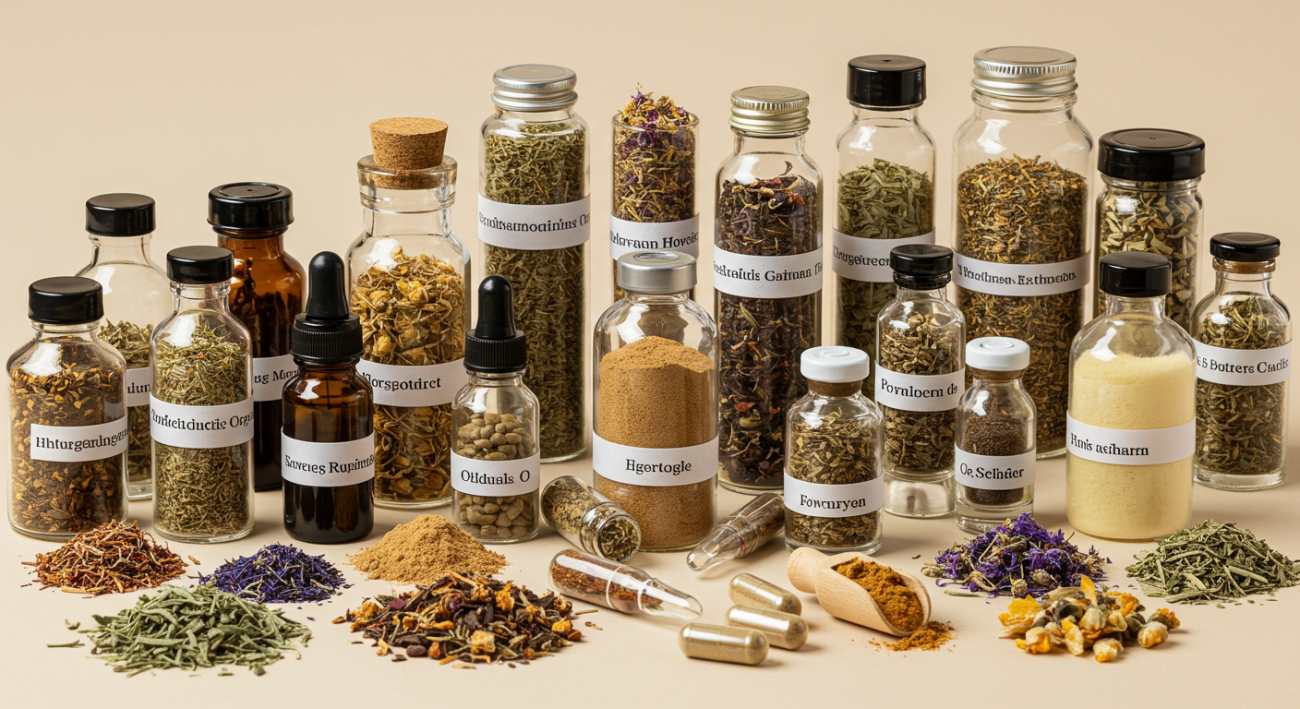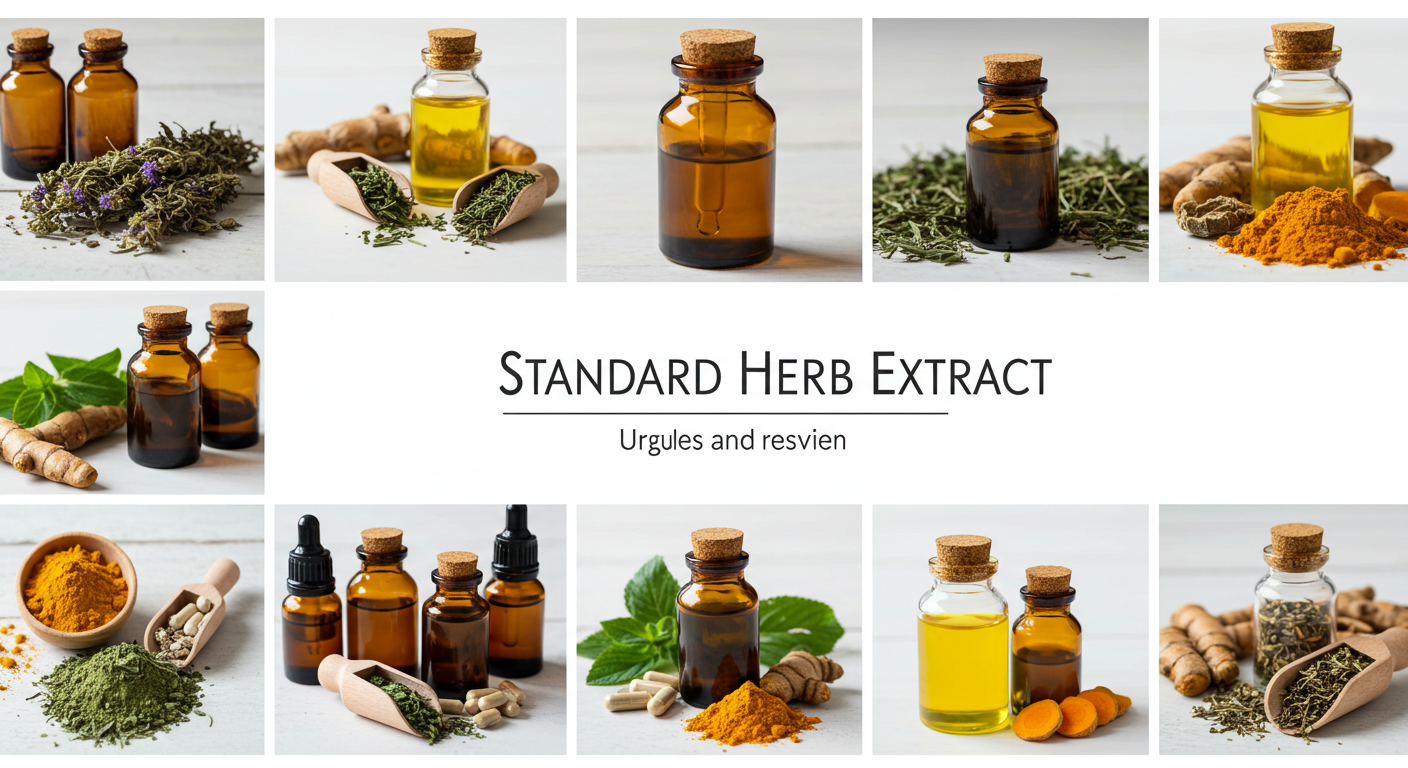A Comprehensive Guide
In the context of natural health and dietary supplements, one commonly comes across standard herb extract. But how does it differ from regular herbal extracts? More importantly, what value does it hold for you? In this comprehensive guide, explain what is a standard herb extract? How it’s produced, and its relevance in supplementation from the perspectives of consistency, safety, and efficacy.
What Does Standard Herb Extract Mean?
What is a standard herb extract? A standard herb extract is a type of plant extract that has undergone processing to contain fixed amounts of one or more active ingredients. Such ingredients are the plant’s phytochemicals that give it beneficial effects. For example, an active component may be contained within a certain concentration, as in turmeric, which contains 95% curcuminoids. This is referred to as the standardization of herbal extracts, and it is conducted to ensure reliable therapeutic effects, dosage accuracy, and dependability in the product.
Definition of Standard Herb Extract
The definition of a standard herb extract involves laboratory analysis and stringent controls for each batch processed. These extracts go through fully controlled processes to assure:
• Defined quantities of active ingredients.
• Uniformity across different batches.
• Freedom from harmful substances such as heavy metals and pesticides.
• Preserved potency over the duration from production to expiration date.
In comparison, full-spectrum extracts or crude powders are prone to uncontrolled variations in strength owing to seasonal or geographic factors about the source plant material.
The Standardization Process: Step-by-Step
This is the procedure followed to standardize herbal extracts:
1. Selection of Botanical Source is
• The process begins with true botanical validation.
• Only the relevant parts of the medicinal plant are collected (root, bark, leaf, etc.).
• Sourcing is often done from certified regions like Yunnan or Shaanxi in China.
2. Extraction
• Solvents like ethanol, water, or CO2 are used.
• The concentration level is defined through extraction ratios, e.g., 10:1 extract.
3. Quantitative Analysis of Phytochemicals
• Processes such as HPLC (High-Performance Liquid Chromatography) and TLC (Thin Layer Chromatography) are categorized under advanced methods.
• There are specific tests that can determine the quantification of flavonoids, ginsenosides, curcuminoids, and others.
4. Standardization
• Defined potency levels, such as 95% polyphenols or 20% ginsenosides, ensure the extract’s potency is adjusted accordingly.
5. Quality Control and Testing
• The following analysis is conducted on each batch:
- Microbiology
- Screening for hazardous heavy metals
- Checking for pesticide residues
- Issuing a Certificate of Analysis (COA)

Advantages of Using Standardized Herbal Extracts
Here is why standardized extracts are considered the gold standard in the supplement industry:
Consistency
• Every dosage is guaranteed to deliver the same results.
Safety
• Extracts are screened for heavy metals, microbes, and pesticides.
Clinical Significance
• Great for evidence-based therapy formulations and therapeutic range dosing.
Enhancement of Absorption
• Some standardized extracts have active compounds that are more bioavailable.
What is the Process of Standardizing Herbal Extracts?
Standardization begins with isolating the compounds responsible for biological activity and therapeutic action, such as curcuminoids in turmeric or ginsenosides in ginseng. This process guarantees that each dose is uniform in strength and safe for consumption.
- Following their identification, these compounds are quantified and modified after extraction. For example, if the active content is low, then the extract could be enriched or blended with natural carriers such as maltodextrin in order to achieve the desired concentration. This process preserves the phytochemical consistency required to ensure health outcomes are reliable.
- To confirm the extraction ratio, purity level, and percentage of active compounds, advanced testing techniques such as High-Performance Liquid Chromatography (HPLC) and Thin Layer Chromatography (TLC) are performed.
- In addition, the supplier issues a Certificate of Analysis (COA), which contains batch-specific information, thereby confirming that the herbal extract is synthesized and standardized according to Good Manufacturing Practices (GMP) and International Organization for Standardization (ISO) specifications.
Adherence to these processes rigorously ensures that every individual product provides consistent results, enables precise dosing, and meets international standards for nutraceuticals.
Why Trust B-Thriving for Standardized Extracts?
At B-Thriving, we uphold that transparency and quality equally have no substitutes.
Here’s what we provide:
• CoA and laboratory reports at the batch level
• Certified ISO 9001 and GMP Facilities
• Procurement from approved Chinese regions
• Clean-label, pesticide-free ingredients
• HPLC testing done internally and by external parties
• The capability to adjust percentages of active compounds
Why B-Thriving for Standard Herb Extracts?
High Purity
At B-Thriving, we take pride in providing high-purity botanical extracts like Bamboo Extract is a versatile, natural ingredient and recognized for its quality around the world. Each batch undergoes testing for active compound concentration, microbial contamination, and solvents. Identification and potency testing of all raw materials is performed at our GMP-certified plants using HPLC and TLC methods. This thorough processing yields clean-label ingredients that are consistent in therapeutic value when used repeatedly.
Competitive Pricing
Effective in-house sourcing and processing improve efficiency, able to provide high quality at lower costs. Our reasonable pricing grants manufacturers better margins and return on investment, whether formulated into nutraceuticals, supplements, or cosmetics.
Prompt Shipping
Taking into consideration global logistics systems, as well as our streamlined order processing systems, we offer shipping for small and large orders without compromising on deadlines. Our shipping infrastructure from China caters to North America, Europe, and other regions seamlessly, ensuring strict timelines are met with dependable precision.
Specialized Guidance
Our skilled technical experts offer thorough product guides, formulation documents, targeted-standard extracts guidance, and preformulating advice. Be it the selection of standard herb extracts or phytochemical profiling, our team provides comprehensive guidance throughout the entire process.
Conclusion
What is a standard herb extract? Standardized herbal extracts are crucial for maintaining purity, potency, and peace of mind. Both manufacturers and consumers require absolute certainty on the contents of herbal supplements. With plant-based wellness booming, selecting the right supplier becomes crucial. B-Thriving: Trust in transparency and Trust in science.

